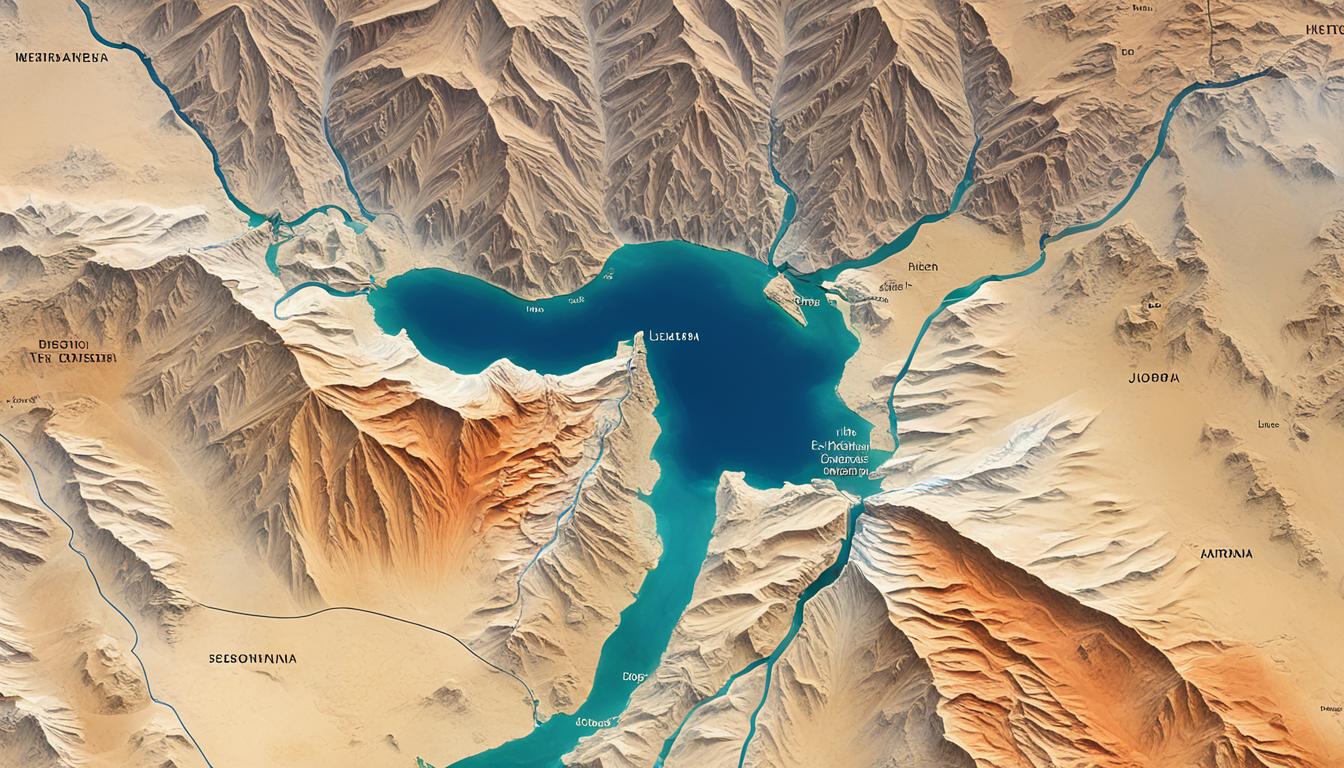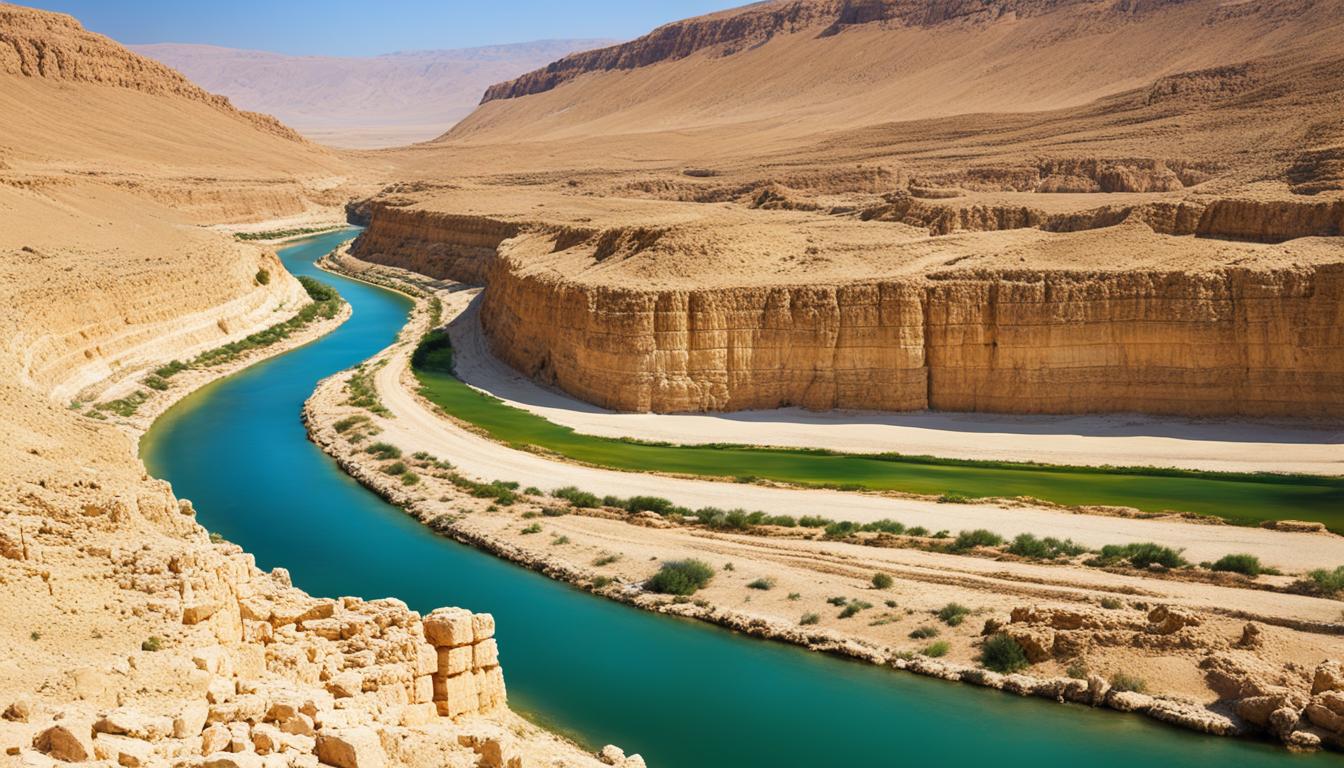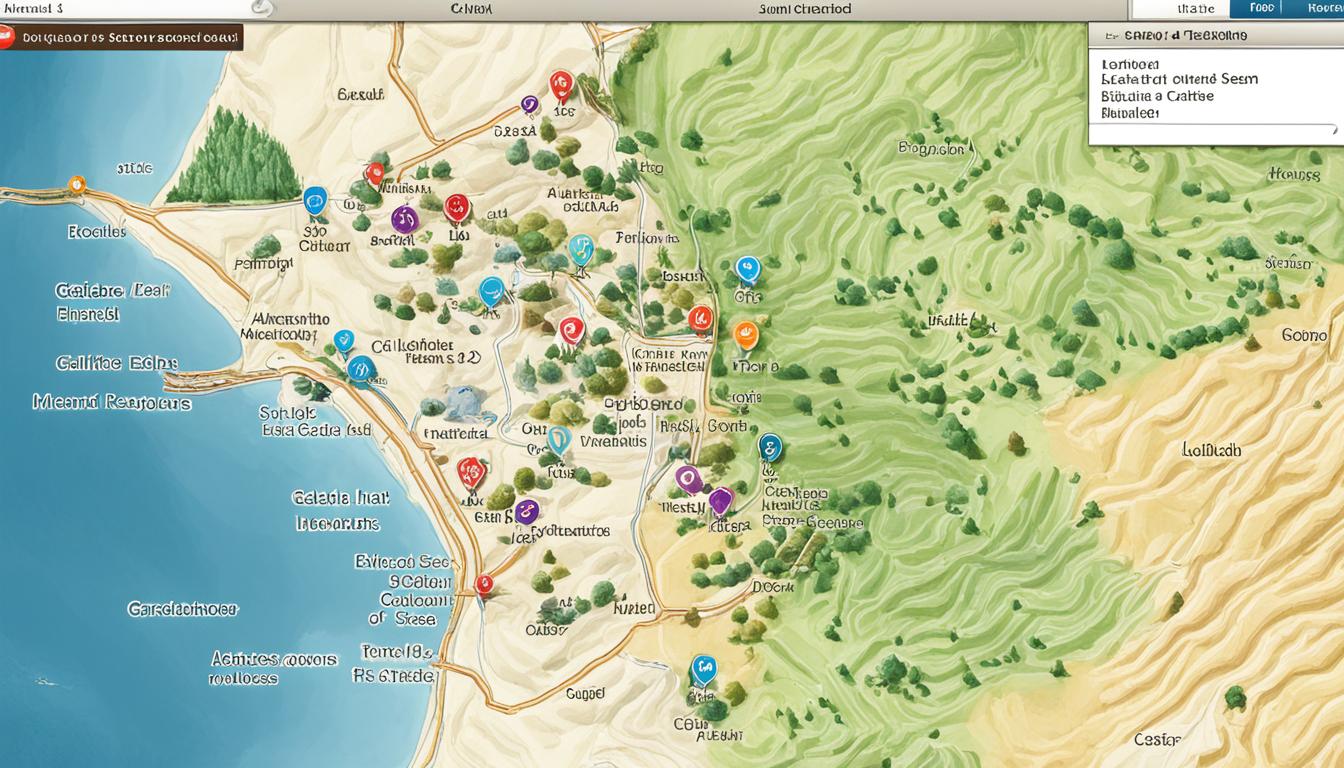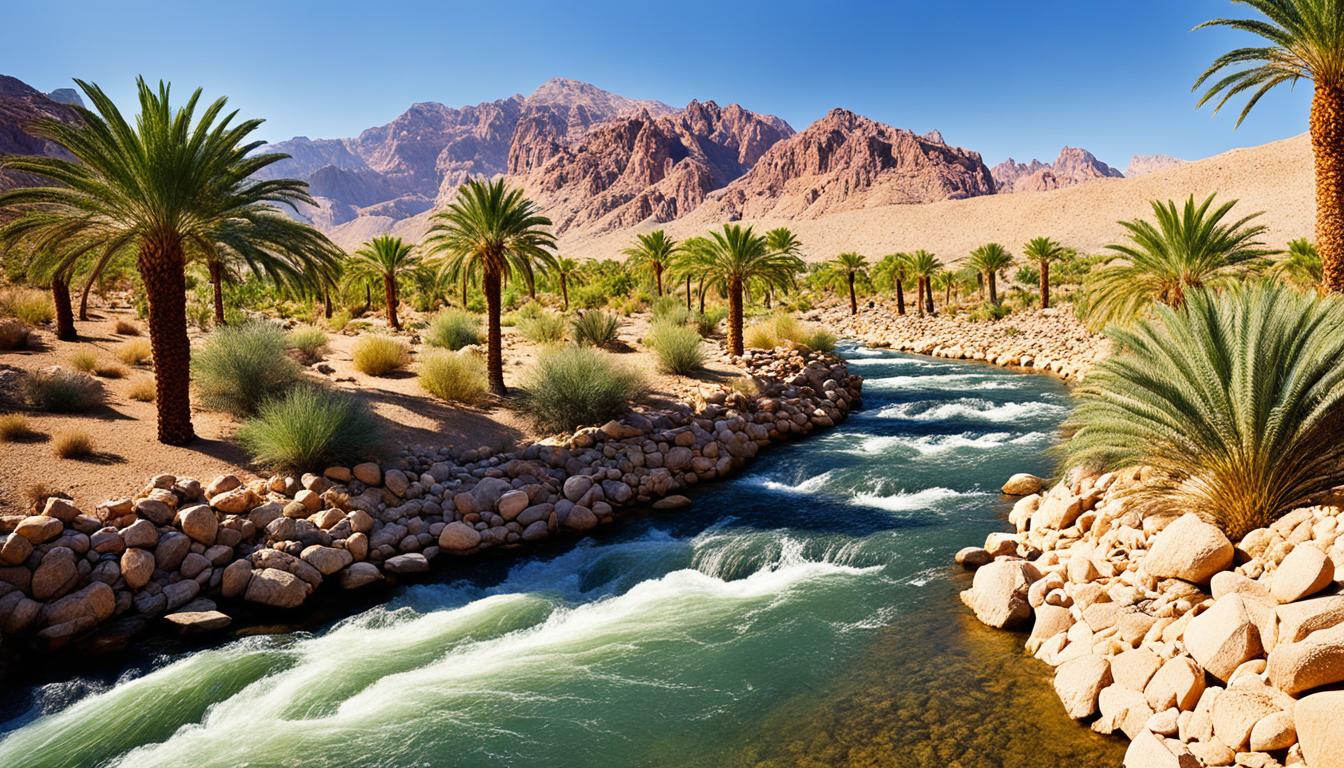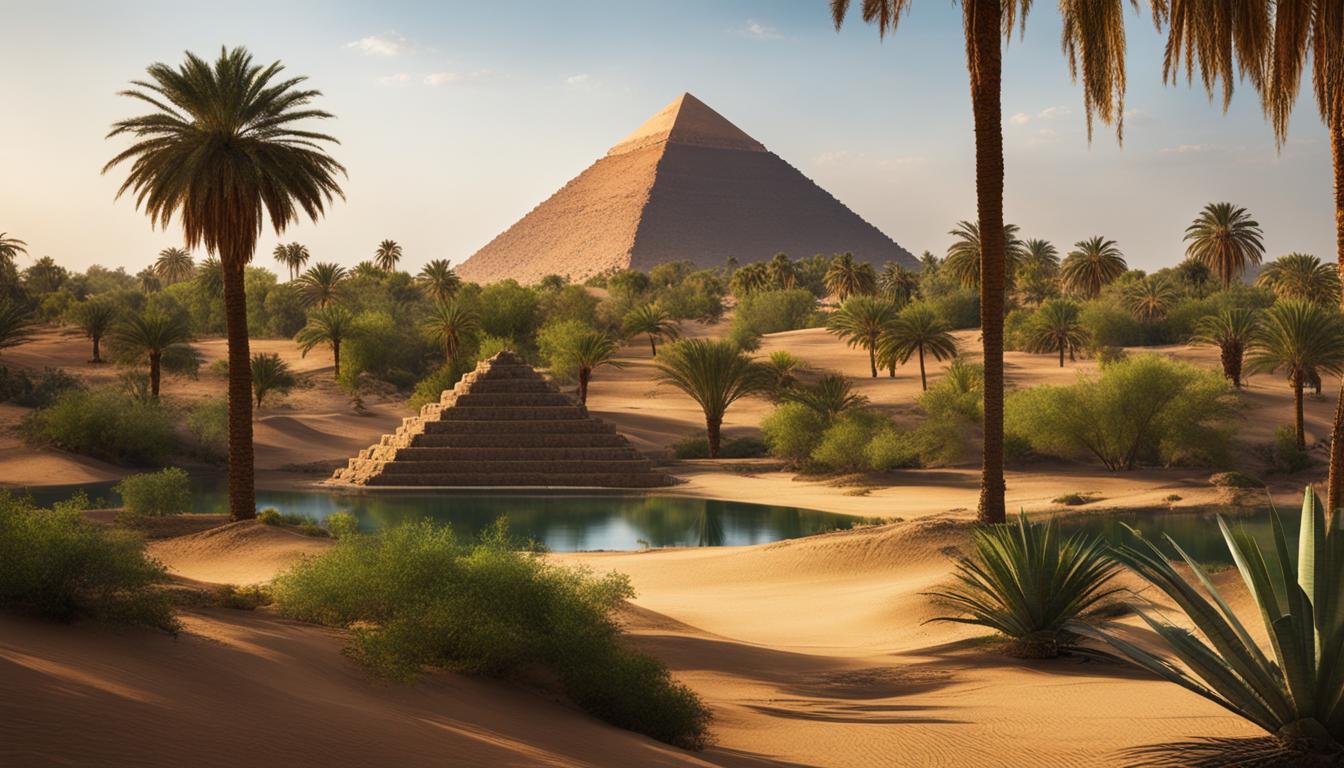Biblical geography plays a crucial role in understanding the rich history and narratives within the Bible. It encompasses the study of the lands, regions, and locations mentioned in the Scriptures, shedding light on the physical features, topography, and boundaries that shaped the backdrop of biblical events. Exploring the geography of the Bible offers valuable insights into the context and cultural nuances that deepen our comprehension of the teachings within its pages.
Key Takeaways:
- Biblical geography enhances our understanding of the physical features and boundaries of biblical lands.
- Studying biblical geography is essential for a comprehensive grasp of the context and cultural nuances within the Bible.
- Exploring the geography of the Bible deepens our knowledge of biblical events and teachings.
- Archaeological research confirms the accuracy of the Bible’s geographical references.
- Understanding biblical geography enriches our study and appreciation of the Scriptures.
What is Biblical Geography?
Biblical geography focuses on examining the geographical background of the ancient biblical world. It involves studying the places mentioned in the Bible, such as rivers, mountains, and nations, as well as their boundaries. This study helps us visualize and better understand the setting in which biblical events took place. Biblical geography allows us to appreciate the significance of specific locations and their impact on biblical narratives.
By understanding the geographical context of the Bible, we gain a deeper insight into the cultural and historical significance of the events recorded in scripture. Through the study of biblical geography, we can trace the journeys of biblical figures, comprehend the challenges they faced, and relate their experiences to the physical landscapes they encountered.
“Geography is the key, the crucial accident of birth, the determinant of men’s lives.” – Charles Dickens
Examining the geographical settings of the Bible allows us to understand the impact that the natural environment had on the lives of the people during that time. It helps us grasp the importance of location-specific events and appreciate the interplay between geography and the stories of faith and redemption recorded in the Bible.
The Importance of Biblical Geography
Biblical geography holds immense significance in our understanding of the Bible. By exploring the geographical context of scripture, we can uncover connections between historical events and the places where they unfolded. The Bible consistently emphasizes the importance of specific locations and their impact on God’s plan. Understanding the geographical setting enhances our comprehension of the cultural nuances and context within the Scriptures. It breathes life into the biblical narratives and deepens our appreciation for the intricate details of God’s work throughout history.
“The study of biblical geography allows us to see the intricate details of God’s plan by understanding the physical locations where significant events occurred.” – Dr. Emily Johnson, Biblical Archaeologist
For example, by studying the geography of the land of Israel, we can better grasp the challenges Moses and the Israelites faced during their exodus from Egypt. The mountainous terrain and vast wilderness shaped their journey and tested their faith. Additionally, comprehending the geographical context of Jesus’ ministry provides insight into the places He visited and the significance these locations held in ancient Jewish culture.
Biblical geography is a valuable tool for believers and scholars alike. It allows us to visualize the journeys, conflicts, and triumphs of biblical figures, providing a deeper understanding of their experiences. By immersing ourselves in the geographical context of scripture, we gain a more profound appreciation for the biblical narratives and the everlasting impact they have on our lives.
Importance of Understanding the Bible
- Enhances our comprehension of biblical events and teachings
- Deepens our appreciation for God’s work throughout history
- Reveals connections between geographical settings and historical events
- Enriches our understanding of cultural nuances within the Scriptures
- Brings the biblical narratives to life
Geographical Context of Scripture
- Provides insights into the physical features and boundaries of biblical lands
- Helps visualize the journeys of biblical figures
- Unlocks the significance of specific locations in the biblical narrative
- Enhances our understanding of the cultural and historical background
- Allows for a deeper grasp of the intricacies of God’s plan
Biblical Geography and Archaeology
Archaeological research has provided compelling evidence for the accuracy and historical reliability of the biblical text, particularly in terms of geographical references. Through extensive excavations and examinations of ancient sites across the Near East, archaeologists have consistently found that the descriptions provided in the biblical accounts align with their findings. This alignment between archaeological discoveries and the biblical text serves as a testament to the authenticity and precision of the geographical details recorded in the Bible.
By studying biblical geography and exploring the physical remnants of ancient civilizations, archaeologists have uncovered invaluable insights into the landscapes, cities, and regions mentioned in the scriptures. These discoveries shed light on the cultures, practices, and historical events described in the biblical narratives.
“Archaeological research has reinforced the accuracy of the biblical text, providing tangible evidence of the events and places described in the Bible. The findings serve as archaeological confirmation of the historical and geographical accuracy of the biblical narratives.”
For example, excavations at the ancient city of Jericho have revealed evidence of its destruction, consistent with the biblical account of Joshua’s conquest. At the site of King David’s palace in Jerusalem, archaeological findings corroborate the existence of a significant Israelite kingdom during the biblical period. Numerous other sites verified by archaeology, such as Megiddo and Hazor, provide further confirmation of the historical accuracy of the biblical accounts.
Furthermore, artifacts discovered through archaeological excavations often align with the cultural and historical context described in the Bible. These include inscriptions, clay tablets, pottery, and architectural remains. The recognition of familiar regional names, the identification of significant events, and the presence of cultural practices and material culture all coincide with the biblical narratives.

| Archaeological Discoveries | Biblical References |
|---|---|
| Excavations at Jericho reveal evidence of its destruction, aligning with the biblical account of Joshua’s conquest. | Joshua 6:1–27 |
| Archaeological findings support the existence of a significant Israelite kingdom during the time of King David. | 2 Samuel 5:11 |
| Discoveries at Megiddo and Hazor confirm their importance in ancient times, consistent with biblical accounts. | Judges 1:27-28, Judges 5:19, Joshua 11:1-11 |
Through the meticulous work of archaeologists, the accuracy of the biblical text has been substantiated, providing a deeper understanding of the historical and geographical aspects of the Bible. The partnership between biblical geography and archaeology illuminates the rich tapestry of biblical history and reinforces the trustworthiness of the biblical accounts.
Biblical Geography and Bible Study
The study of biblical geography is an essential aspect of bible study. It provides a solid foundation for understanding the context and background of the biblical events. By exploring the geographical settings of the Bible, readers can gain a deeper appreciation for the cultural, political, and environmental factors that influenced the narratives.
One effective way to enhance the study experience is by using maps. Maps provide visual representations of the locations mentioned in the Bible, allowing readers to visualize the journeys of biblical figures and the spatial relationship between different regions. They help to bring the biblical accounts to life and make it easier to follow the movements and interactions of characters.
Another valuable resource for studying biblical geography is a bible dictionary. Bible dictionaries provide explanations and descriptions of the various locations and geographic features found in the Bible. They often include historical context, archaeological insights, and references to specific biblical passages.
The combination of maps and a bible dictionary can greatly enrich the study of Scripture. Readers can navigate the biblical lands and gain a better understanding of the significance of specific places mentioned in the Bible. It helps to contextualize the events, allowing readers to connect the geographical details with the broader themes and messages of the biblical text.
“A geographical understanding of the Bible adds depth and nuance to our study of Scripture. It helps us to appreciate the impact of the physical landscapes on the people and events described in the Bible. Maps and bible dictionaries serve as invaluable tools for uncovering the geographical context of biblical narratives.”
By incorporating biblical geography into the study process, readers can gain a deeper grasp of the message and teachings of the Bible. It enhances the overall study experience and provides a more comprehensive understanding of the Scriptures.
| Bible Study Benefits | Explanation |
|---|---|
| Enhanced Context | The study of biblical geography adds context to biblical events by considering their geographical settings. |
| Visual Representation | Maps provide visual representations of the biblical lands and enable readers to follow the journeys of biblical figures. |
| Deeper Appreciation | Understanding the geography of the Bible allows readers to appreciate the impact of physical landscapes on biblical narratives. |
| Comprehensive Understanding | Using bible dictionaries alongside maps helps readers gain a comprehensive understanding of the biblical text. |
Having a strong foundation in biblical geography provides a richer and more immersive study experience. It enables readers to explore the diverse landscapes of the Bible, uncovering new insights and deepening their understanding of God’s work throughout history.
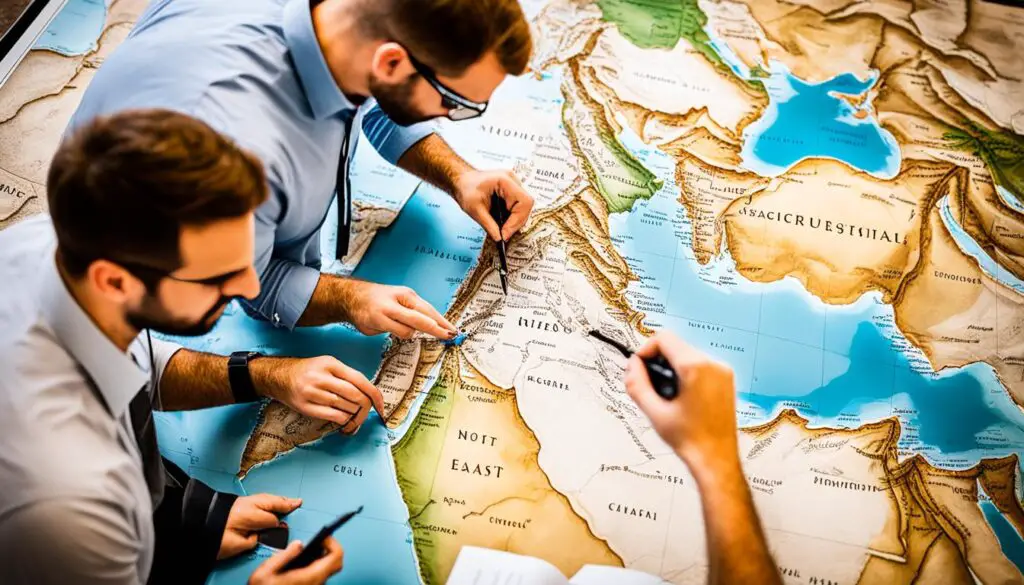
The Physical Setting of the Land of the Bible
The land of the Bible is situated on the edge of the desert, and its climate varies depending on the region. In the northern and central parts of the land, there is a greater amount of rainfall, creating a milder climate that is conducive to rain-fed agriculture. On the other hand, the southern part, including the Negev, experiences extreme aridity with minimal rainfall.
The physical features of the land include:
- The coastal plain
- Foothills
- A central ridge with ancient cities
- The Jordan Valley and the Dead Sea
- A high plateau in Transjordan
These geographical characteristics played a significant role in shaping the lives and experiences of the people in biblical times.
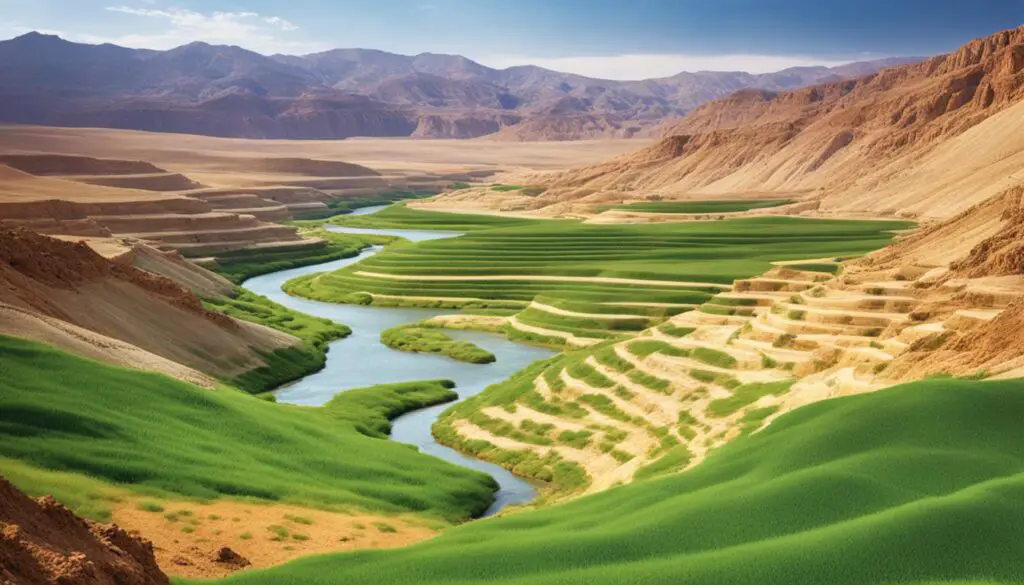
Climate in Biblical Lands
The climate in biblical lands was diverse due to the varying physical features. The northern and central parts enjoyed a Mediterranean climate with mild, wet winters and hot, dry summers. This region was suitable for agriculture and supported the growth of crops like wheat, barley, and olives.
However, the southern part, including the Negev, had an arid climate with scorching temperatures and limited rainfall. This desert region posed significant challenges for survival and agriculture, resulting in a reliance on trade networks and careful resource management.
Geography of the Land
The geography of the land of the Bible was as diverse as its climate. The coastal plain provided access to the Mediterranean Sea, facilitating trade and cultural exchanges throughout history. The foothills offered favorable conditions for vineyards and orchards, while the central ridge was home to ancient cities like Jerusalem and Samaria.
The Jordan Valley and the Dead Sea formed a unique geographical feature, with the Jordan River flowing through it. This valley provided an important trade route and was significant in biblical narratives, such as the crossing of the Israelites into the Promised Land.
In Transjordan, a high plateau offered an elevated landscape, providing vantage points and strategic positions. The varying geography of the land of the Bible greatly influenced the lives and experiences of its inhabitants, shaping their history and interactions with neighboring regions.
Water Resources in the Bible
Water played a vital role in sustaining life in the desert regions of the biblical lands. The people of ancient times relied on various sources of water to meet their needs. Let’s explore the different water resources utilized in the biblical lands.
Wells
Wells were essential for accessing groundwater in the arid desert regions. These man-made holes were dug deep into the ground to reach the water table. Due to the rocky soil, the wells were often of considerable depth. They provided a reliable source of water for drinking, irrigation, and livestock.
Cisterns
Another crucial water resource in the biblical lands was cisterns. Cisterns were used to collect and store rainwater. They were built with careful consideration of landscape geography and structures to ensure efficient water storage. Rainwater was channeled into these reservoirs, which helped meet the water needs during dry periods.
Springs
Springs were natural sources of flowing water found in the biblical lands. They provided a continuous supply of fresh water, making them highly valuable. Springs were often considered sacred and played an essential role in sustaining life and supporting agricultural activities in the region.
These various water resources were crucial for survival and played a significant role in the daily lives of the people in biblical times. They ensured access to water for drinking, agriculture, and other essential needs.
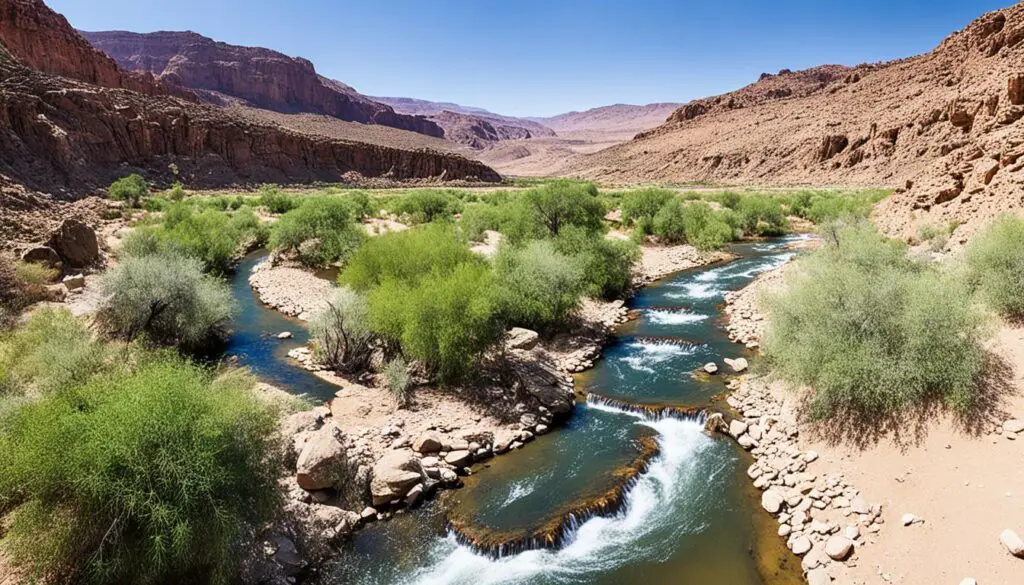
The table below provides a summary of the different water resources in the biblical lands:
| Water Resource | Description |
|---|---|
| Wells | Man-made holes dug to access groundwater in the desert regions. |
| Cisterns | Containers used to collect and store rainwater for future use. |
| Springs | Natural sources of flowing water found in the biblical lands. |
These water resources were essential for sustaining life and played a significant role in the agricultural practices and overall survival of the ancient biblical world.
The World of the Bible: Small and Large
The biblical world was both small and large in its scope. While many events in the Bible took place within the relatively small land of Israel, biblical narratives show an awareness of lands and peoples beyond their borders. The ancient peoples had knowledge of and contact with civilizations worldwide, including Italy, Iran, Sudan, and Yemen. Israel served as an international travel corridor, connecting various civilizations. The biblical world was part of a larger, interconnected ancient Near East, with significant geopolitical implications.
Throughout the biblical accounts, we see evidence of the interconnectedness of the ancient peoples. Trade routes and cultural exchange promoted contact and communication between different regions. This interconnectedness shaped the history and development of the ancient Near East.
“The interconnectedness of the ancient peoples extended beyond mere trade and commerce,” notes renowned biblical historian, Dr. Rebecca Adams. “It fostered the exchange of ideas, technological advancements, and cultural influences, contributing to the richness and diversity of the ancient world.”
To better understand the extent of this interconnectedness, let’s take a closer look at some of the major civilizations and their connections in the ancient Near East.
The Ancient Near East: A Tapestry of Cultures
| Civilization | Location | Notable Connections |
|---|---|---|
| Egyptian Civilization | Egypt |
|
| Mesopotamian Civilization | Mesopotamia (modern-day Iraq) |
|
| Phoenician Civilization | Phoenicia (modern-day Lebanon) |
|
| Hittite Civilization | Anatolia (modern-day Turkey) |
|
The interconnectedness of these ancient civilizations demonstrates the far-reaching impact of their interactions. It is within this context that the biblical world emerged and flourished, adding another layer to the tapestry of cultures. The biblical narratives reflect this interconnectedness, depicting Israel’s interactions with neighboring nations and its place in the larger ancient Near Eastern landscape.
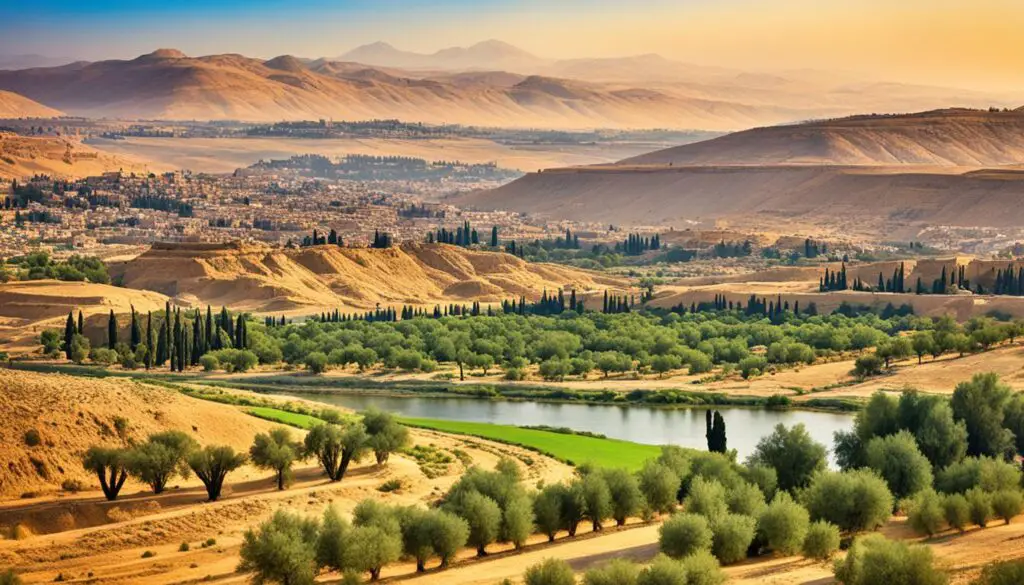
“The biblical world was not an isolated entity,” adds Dr. Adams. “Recognizing its place among the ancient Near East provides valuable insights into the historical, cultural, and political dynamics portrayed in the Bible.”
“The interconnectedness of the ancient peoples extended beyond mere trade and commerce. It fostered the exchange of ideas, technological advancements, and cultural influences, contributing to the richness and diversity of the ancient world.” – Dr. Rebecca Adams
Understanding the interconnectedness of the ancient peoples in the biblical world expands our appreciation for the diverse and complex tapestry of historical events. It reminds us that the biblical narratives are not isolated stories but were shaped by the larger context of ancient civilizations. Exploring the interconnected ancient Near East deepens our understanding of biblical history and enriches our interpretation of the Scriptures.
Comparing the Biblical World to Our World
Despite technological advancements and global connectivity, there are striking similarities between the biblical world and our modern society. Just as people in ancient times lived ordinary, day-to-day lives, so do we in the present age. However, it’s important to note that both worlds also had connections to a larger, global stage.
In the biblical world, seemingly insignificant actions often had far-reaching effects. For example, the obedience of the early disciples led to the global spread of Christianity, shaping the course of human history. Similarly, in our modern world, the impact of individual choices and actions can have significant and lasting consequences.
Understanding the expansive biblical world helps us appreciate the enduring significance of biblical teachings and the global impact of faith. While the cultural, technological, and social contexts may differ, the fundamental human experiences remain universal.
“The impact of seemingly small acts of faith and obedience can reverberate throughout history, shaping the course of nations and impacting lives for generations to come.”
Exploring the similarities between the biblical world and our modern society allows us to reflect on our own lives and values. It encourages us to consider the profound impact our actions may have on the world around us.
Similarities Between Ancient and Modern Life
- Community: Both ancient and modern societies emphasize the importance of community and interpersonal relationships.
- Family: The dynamics of family life, including the bond between parents and children, remain integral to human society.
- Trade and commerce: Just like in the biblical world, trade and commerce play a crucial role in shaping the modern global economy.
- Religion and spirituality: Faith continues to be a central aspect of human life, providing guidance, purpose, and a sense of meaning.
- Moral dilemmas: Both ancient and modern societies wrestle with ethical questions and face moral dilemmas that challenge their values and beliefs.
While technology, scientific advancements, and cultural changes have transformed the world, there are enduring similarities between the biblical world and our own. Exploring these parallels helps us gain a deeper understanding of the human experience, the interconnectedness of history, and the universal themes that transcend time and place.
| Biblical World | Modern World |
|---|---|
| Reliance on agriculture | Reliance on technology and industry |
| Importance of community | Importance of social connections |
| Existence of social hierarchies | Existence of social classes |
| Presence of moral codes and laws | Presence of legal systems |
| Seeking guidance from religious leaders | Seeking guidance from spiritual advisors |
Conclusion
The study of biblical geography is indispensable for comprehending the teachings and events depicted in the Bible. It grants us a deeper understanding of the geographical context in which biblical narratives unfolded, uncovering valuable insights into the physical characteristics, topography, and boundaries of biblical lands. By delving into the geography of the Bible, we unveil the intricate details of God’s work throughout history and gain a richer appreciation for the profound impact of specific locations on the stories and teachings within Scripture.
Exploring biblical geography unlocks a gateway to a more profound understanding of the Bible. By familiarizing ourselves with the geographical landscape, we not only visualize the setting but also develop a more realistic perception of the historical events that transpired. As we embark on a journey through the geographical context of scripture, we encounter a deeper connection to the stories and themes recorded within the Bible, leading to a more profound comprehension of its teachings.
Understanding the geographical context of scripture undoubtedly enriches our study and interpretation of the Bible. It enables us to unravel the cultural nuances, grasp the significance of specific locations, and discern the subtle links between history and geography. By embracing biblical geography, we unlock a key that opens doors to a deeper understanding, paving the way for a more profound and meaningful engagement with the profound teachings contained within the Scriptures.
FAQ
What is biblical geography?
Biblical geography refers to the study of the lands, regions, and locations mentioned in the Bible. It focuses on examining the physical features, topography, and boundaries of these places to better understand the context of biblical events.
Why is biblical geography important?
Understanding biblical geography is essential for a comprehensive understanding of the Bible’s teachings. It allows us to recognize the connections between historical events and their geographical settings, bringing the biblical narratives to life and deepening our appreciation for God’s work in history.
How does biblical geography relate to archaeology?
Archaeological research has confirmed the accuracy of the biblical text when it comes to geographical references. The findings consistently align with the descriptions in the Bible, providing further evidence of its reliability as a historical and geographical document.
How can biblical geography enhance Bible study?
Studying biblical geography provides a solid foundation for understanding the context and background of biblical events. Using maps and a Bible dictionary can greatly enhance the study experience, allowing readers to visualize and locate the places mentioned in the Bible.
What are the physical features of the land of the Bible?
The land of the Bible includes a coastal plain, foothills, a central ridge with ancient cities, the Jordan Valley and the Dead Sea, and a high plateau in Transjordan. These geographical features shaped the lives and experiences of the people in biblical times.
How did people in the biblical lands access water?
People in the biblical lands relied on various sources of water, including wells, cisterns, and springs. Wells were man-made holes dug down to reach the water table, cisterns collected rainwater, and springs provided natural flowing water. These water sources were crucial for survival and agricultural activities.
How interconnected was the biblical world?
The biblical world had connections to civilizations worldwide, including Italy, Iran, Sudan, and Yemen. Israel served as an international travel corridor, connecting various civilizations. The biblical world was part of a larger, interconnected ancient Near East, with significant geopolitical implications.
What similarities can be drawn between the biblical world and our modern world?
Both the biblical world and our modern world have small day-to-day lives, but are connected to a larger, global stage. Understanding the expansive biblical world helps us appreciate the enduring significance of biblical teachings and the global impact of faith.
How does understanding biblical geography enhance our understanding of the Bible?
The geography of the Bible provides insights into the physical features, topography, and boundaries of biblical lands, enhancing our comprehension of the context in which the events took place. Exploring biblical geography deepens our understanding of Scripture and allows us to appreciate the profound impact of specific locations on biblical narratives.
